
The second phase of our farewell tour of America (if a Cher-style farewell tour, with little pretense of actual long-term retirement and plans for future performance more or less already locked in) has begun. The first phase took us north, up the West Coast from Los Angeles to Alameda, Ashland, Portland, Seattle, Vancouver, and back down through Eugene, Sunnyvale, and Santa Barbara. This much more ambitious phase has us crossing the U.S. of A in the other direction, starting from Huntington Beach and ending up, theoretically, in Raleigh, North Carolina — coast to coast. First stop: Barstow, a town I (as I assume many do) know only from the first line of Fear and Loathing in Las Vegas: “We were somewhere around Barstow on the edge of the desert when the drugs began to take hold.”

With or without the drugs, I do get the sense that Barstow, now as then, serves primarily as a waypoint to Vegas, the fork in the road at which you must choose whether you really want to commit to the Sin City experience. Part of that came from the all-foreigner crowd around me in the breakfast room offered by our lodging for the night, one of many such establishments along what looked like Barstow’s motel mile: the silent young Germans, the gregarious old Brits. (Actually, I observed the highest level of gregariousness in the motel’s Indian owner, who told of his life’s previous chapter in Johannesburg and had probably insisted on the place’s most memorable touch, each and every room’s towels having been folded into little elephants.)
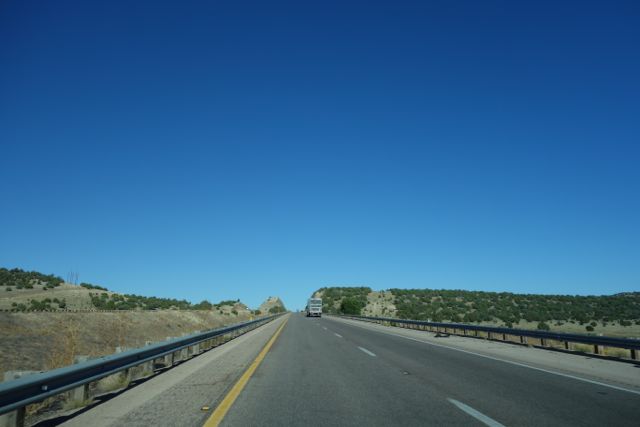
Even before launching into this ultimate American experience, I came up with a theory about the homeland of which I’ll soon take leave: America, as I see it, mashes up the forbiddingly eccentric with the frictionlessly generic. Part of that impression comes from the folksy roadside attractions that captivate so many visiting non-Americans (In these two weeks, I will live Wim Wenders’ dream). Another part comes from my favorite passage of my favorite Los Angeles novel, Christopher Isherwood’s A Single Man, whose English expat protagonist berates his countrymen for failing to understand how America has “reduced the things of the material plane to mere symbolic conveniences,” and that “until the material plane has been defined and relegated to its proper place, the mind can’t ever be truly free.”
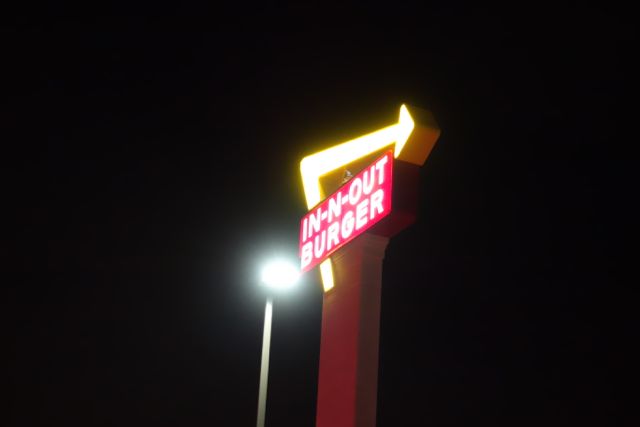
We Americans, he says, “sleep in symbolic bedrooms, eat symbolic meals, are symbolically entertained and that terrifies them” — those “groveling little materialist” Europeans” — “fills them with fury and loathing because they can never understand it.” Experiencing America therefore means experiencing its generic spaces, and as we headed toward not Las Vegas but Flagstaff, Arizona, we experienced one of its finest: In-N-Out Burger, a reassuringly guaranteed presence alongside southern California’s freeways. We’d meant to end our last road trip with a protein-style hamburger and animal-style cheeseburger, but it didn’t happen, and so with a protein-style hamburger and animal-style cheeseburger our latest road trip begins.

The impetus for this road trip across America came from my dad’s move across America, from Huntington Beach to Raleigh. He’s driving the moving truck full of the last load of boxes, furniture, and such, and we’re driving his newly purchased Kia Sorento. I’ll probably have driven more in these two weeks than I’ve driven in the past decade, or than I will drive in the next decade — after this, I won’t want to drive for about a decade — and my perpetual out-of-touchness with the driving experience keeps me astonished whenever I see, much less use, the features built standard into automobiles these days. I mean, you don’t even need keys anymore!
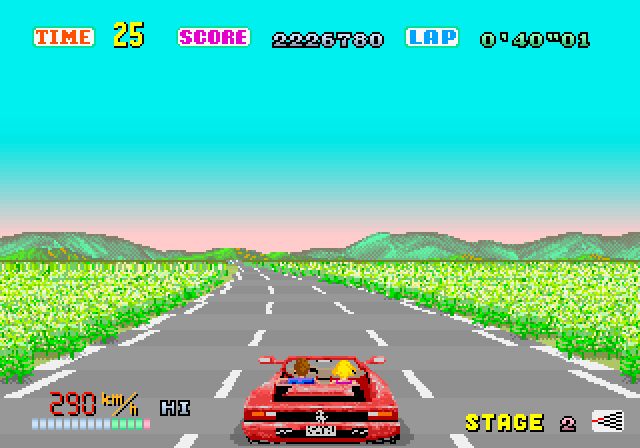
These days, one hears a lot about the approaching debut of self-driving cars on the market, but I sense that non-self-driving cars are themselves asymptotically approaching the condition of the self-driving car. I sense it with special strength while rolling down Interstate 40 at a both climate- and cruise-controlled 85 miles per hour, glancing at the navigation system’s screen every few hours in order to find out where to exit next. When it displays that, it even assembles a reasonable graphical approximation of the scenery outside the windows, images reminiscent of the backgrounds in Sega’s OutRun, the very first video game I ever owned (albeit in a conversion for a Radio Shack PC clone).
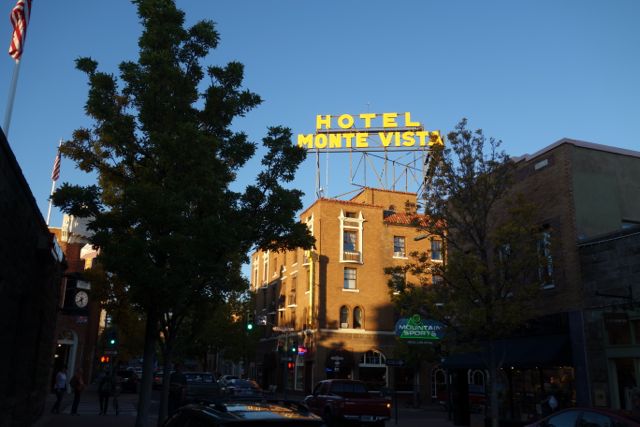
I always liked that OutRun‘s creator Yu Suzuki insisted on describing it not as a racing game, but as a “driving game.” Now, 25 years later, it feels like all those hours I spent playing it in the basement have paid off, since the essential tasks of this real-live driving experience differ not at all from those of the driving game: go forward, occasionally choose which way at a fork in the road, get to the next destination on time, and try not to run into other cars. But in real life, I have a much more appealing lady in the passenger’s seat (though the way the Outrun girl would point accusatorially at the driver after each and every crash — or really, the way adults laughed when they saw it — told me all I needed to know about male-female relations in this world), and we passed today not into some pixelated Japanese fantasy of a Californian beach or alpine Mitteleuropa, but Flagstaff, Arizona.
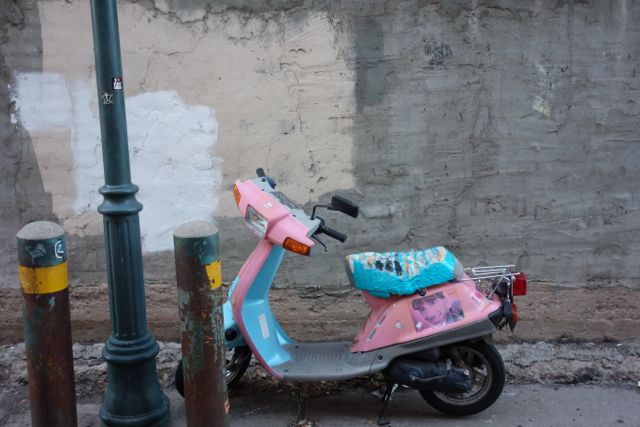
Going to Arizona after a string of sweltering days even in California seems like a bad Idea, I realize, but Flagstaff, due to its high altitude and maybe some other environmental factors I’m not going to look into, gets cold, at least at night. And what better way to pre-emptively warm up than drinks at my coffee cocktail spot of choice in town, the Flagstaff Coffee Company? Actually, it ranks as my coffee cocktail spot of choice in any town, since I’ve never encountered anyplace else that specializes in mixing coffee and alcohol, especially not in at least eighteen different configurations. I went with the classic Irish coffee (which I suppose I could have had in Los Angeles, where we live four miles from The House of Irish Coffee), but Jae got an ideal last-minute suggestion of an off-menu item from some regular sitting nearby that involved matcha, whiskey, and almond milk.

After night fell and the Flagstaff chill set in, we ascended to the Lowell Observatory and saw the city from above as we waited in line to look through the telescope in the 120-year-old observatory building once used by Percival Lowell himself (and now standing mere feet from his mausoleum). One of the complex’s warmer indoor exhibits devoted to Lowell’s life and discoveries displayed an 1883 photo of him in a group of Koreans. “Lowell’s past before becoming an astronomer is also rather interesting, as he lived in in Japan for a number of years in the 1880s and 1890s, before returning home for good in 1893,” writes (past Notebook on Cities and Culture guest) Matt VanVolkenburg. “In 1883 he was invited to accompany Korea’s first trade mission to the US,” on which trip he posed for the picture in question.
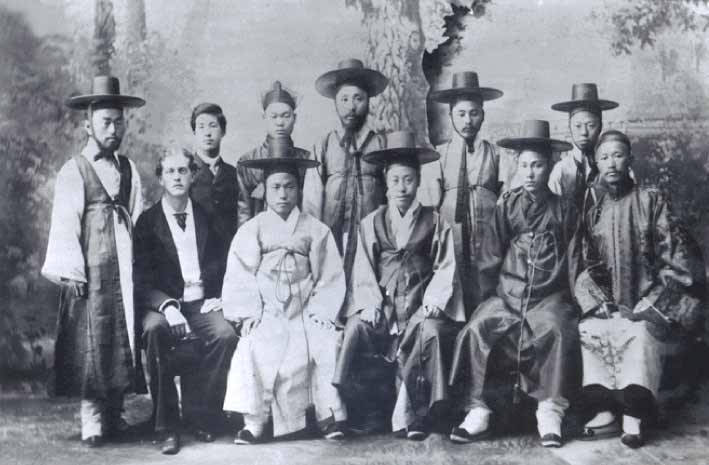
“Upon returning to Korea in late 1883, he stayed several months in Korea, where he witnessed the 1884 coup d’etat, which he wrote about in the November 1886 issue of The Atlantic Monthly (which can be found here). He also took a number of photos of Korea at that time, which can be found here (click’ search’). Lowell also published Choson, Land of the Morning Calm: A Sketch of Korea in 1886, as well as a number of books on Japan, such as The Soul of the Far East and Noto: an Unexplained Corner of Japan.” And so, 7,250 feet above sea level, I seem to have paid inadvertent tribute to one of my predecessors.
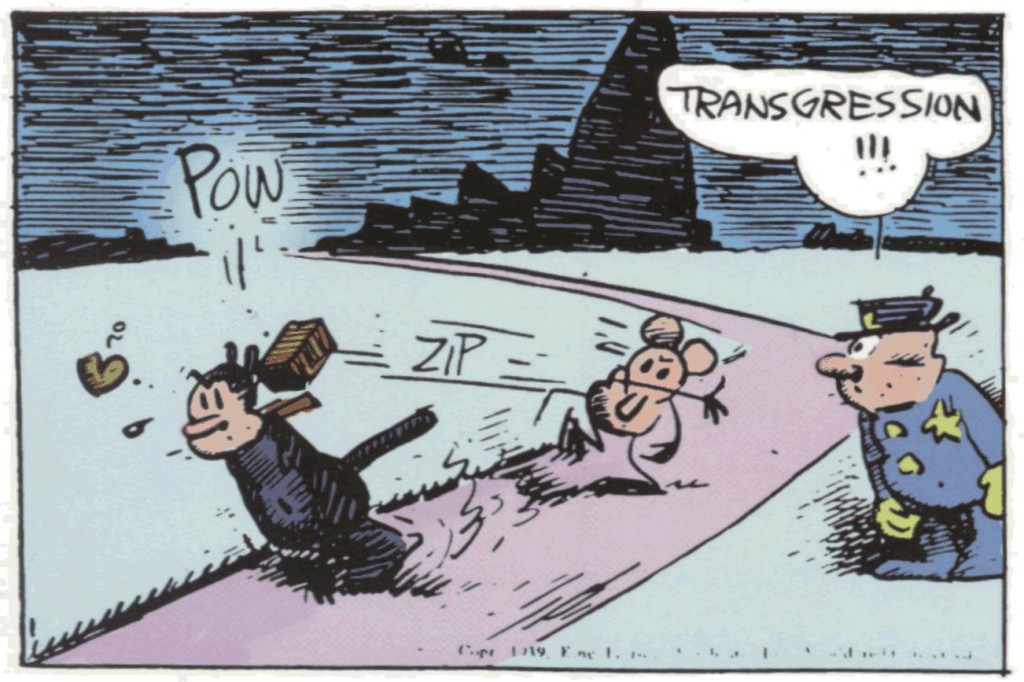
Living in southern California, one gets to Arizona every now and then, but to get to New Mexico requires something like volition — which means I certainly hadn’t set foot in New Mexico before. Nor had I ever actually driven over the California-Arizona border, the point at which the landscape goes all Krazy Kat. Having read collections of that strip over and over again in childhood (I got deep into prewar newspaper comics for a while there, which seemed to speak to me of a better, more nonsensical time), I remembered that George Herriman drew a great deal of aesthetic inspiration from the American southwest, but I’d forgotten that its setting of Coconino County takes its name from an actual county in western Arizona.

But New Mexico looks even more Coconino County than Coconino County. After what felt like a few hours of admiring the landscape, we made our first New Mexican stop in Gallup, a town along Route 66. Those on the Krazy Kat tour of the southwest — or, indeed, anyone with a certain idea of America — will want to spent some time attempting to get their kicks on Route 66, but all I’ve seen of it suggest that few kicks remain to be had. Countless other observers of American life have said this better, but most towns serviced primarily by the withered bloodstreams of the railroads or the old U.S. Highway System, rather than the mighty arteries of the Interstate Highway System, have become towns on life support.
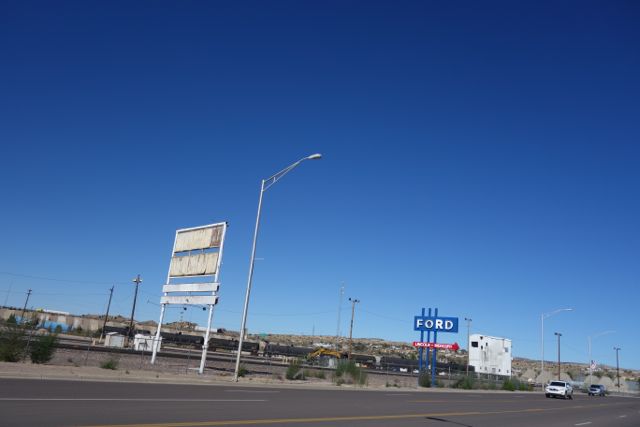
And so at least half of Gallup’s businesses along Route 66 have permanently shuttered, some of them what looks like decades ago. Of those that remain, many have posted loud “BUYING PIÑONS” notices in their windows. Piñons, it turns out, are nuts that grow on local pine trees, and though a surprisingly robust economy appears to have grown around them, nothing about it strikes me as a good sign. But just a block or two off the forlorn Main Street of America, we found a café in continuous operation since 1970 that gave us a heartening dose of New Mexican cuisine. And by New Mexican cuisine, I mean one comestible above all: the sopaipilla.
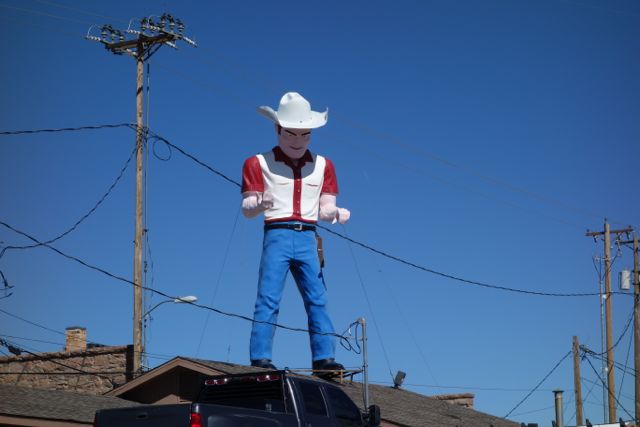
I first learned about sopaipillas from Adam Cadre’s novel Ready, Okay!, whose protagonist delivers what I recall as a rapturous monologue in praise of their deliciousness. Still, it took me years to actually try one since, at the time, something about the spelling — particularly that “I” in the middle — struck me as unnecessary, show-offy. But these lightly fried, unsweetened pillows of steam-filled dough have nothing excessive about them, and despite the importance of cutting back on one’s food intake while on the road, I find myself able to put away two or three of them at a sitting without even realizing it. Some of this gluttony I put down to a simple when-in-Rome enjoyment of place and the culinary culture thereof. Some of it I explain away as a desire to put a little more money into a local economy clearly in dire need of it. And besides, where am I going to get a decent sopaipilla in Seoul?
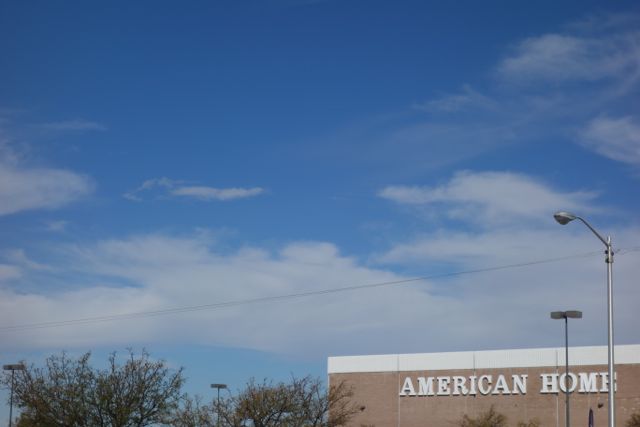
Even just 800 miles into this trip, I don’t care if I never see another “unspoiled” landscape again. Spend enough hours driving through rolling hills or dry scrub or big skies or whatever, and you — or at least I — start to long for any sign of civilization, no matter how unpromising, even just a billboard telling you you’re going to hell. And so I met the modest Albuquerque skyline, the pyramidical tops of the Albuquerque Plaza towers jutting stubbily but distinctively into the air, with something like rapture. Finally, back in a city — maybe only the 34th largest in America, but a city nonetheless!
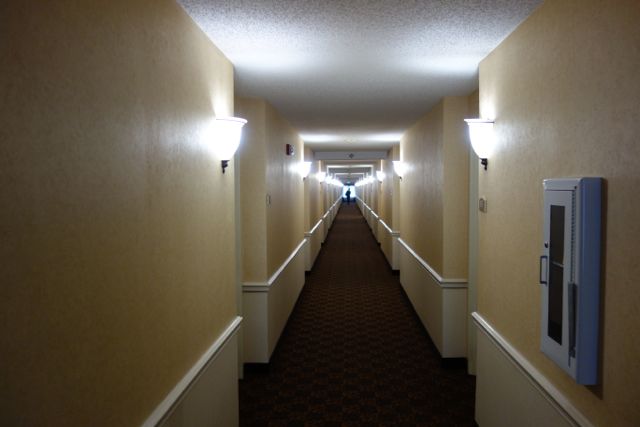
There we stayed in what I consider one of America’s truly, fascinatingly generic spaces: a Holiday Inn Express. I’ve only stayed in about a dozen Holiday Inn Expresses in my time, but even that has led me to expect that, when you stand inside one, you stand in no particular neighborhood, no particular city, and indeed no particular country: you stand in a Platonic hotel realm, standardized to perfection. The Holiday Inn Express realizes, to bring it back to A Single Man, George’s vision of America, in which a “hotel room isn’t a room in a hotel, it’s the room, definitively, period. There is only one: The Room. And it’s a symbol — an advertisement in three dimensions, if you like — for our way of life. And what’s our way of life? A building code which demands certain measurements, certain utilities and the use of certain apt materials; no more and no less. Everything else you’ve got to supply for yourself.”
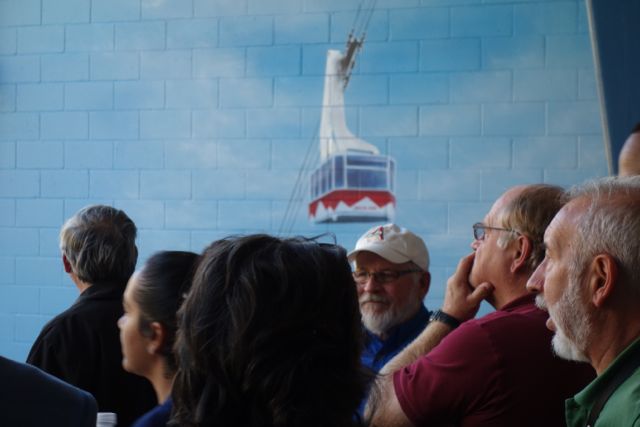
And so, despite spending two nights in Albuquerque’s Holiday Inn Express, I perhaps spent even less time in Albuquerque than I thought. I often laugh at those New York Times “36 Hours in…” travel guides, but the country-crossing exigencies of this trip put me in a psychological position where I’d kill for 36 hours in one city. But their “36 Hours in Albuquerque” didn’t include what, for me, ranks as a destination of paramount importance: Burt’s Tiki Lounge, which Thrillist’s guide to the tiki bars of America describes as “like stepping into a TGI Friday’s that married a dive bar in Oahu, then wandered off into the desert to raise their weird kids.” Alas, my desperate need for such a dive went unfulfilled; we turned up at 8:30, when every reliable source said they’d open in the evening, but its doors stayed locked, its neon stayed unlit. The on-the-ground impression I take from New Mexico’s largest city thus amounts to not much more than brightly colored freeways and metal sculptures of various desert creatures real and imaginary.

But we got a much more vivid impression from the air by taking the Sandia Peak Tramway, which offers a fifteen-minute ride up a cable to a restaurant from whose vantage you can take in a full nine percent of the state of New Mexico while drinking margaritas. (IF YOU GO, as the travel articles would put it, don’t forget to order them in plastic cups so you can take them out to the deck.) This being the 21st century, a great many of the tram’s riders held their phones to the window as we ascended. I had my camera too, but I couldn’t figure out a non-obvious shot to take, so I just waited until the sun went down and the lights came on, snapping the kind of shot from the tramway’s boarding platform that almost never works. But this time it worked.

If Gallup exemplifies the struggling Route 66 town, Tucumcari exemplifies the kind that has simply laid down. We pulled in off the 40 to check out an expresso bar with an airplane permanently parked next to it that my dad told us about, but between there and the freeway exit we passed many more dilapidated, abandoned, or collapsed buildings than structurally or economically sound ones. The plane has stayed in place and the espresso bar still stands, built into the end of one of Tucumcari’s just-hanging-on motels (though lord knows what kind of white-trash crimes were occurring in them even as we passed), but it had closed for the day, as every day, at 11:00 a.m. “That must be check-out time,” Jae said — and why bother holding out hope for customers after that?
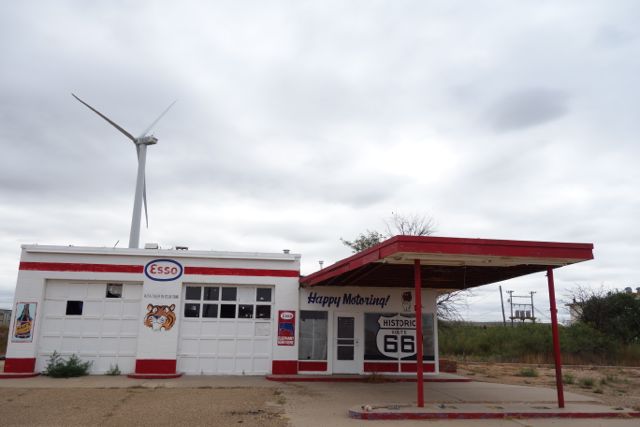
Besides the occasional motel, the still-operational establishments on Tucumcari’s stretch of Route 66 include a Jehovah’s Witnesses Kingdom Hall and — by far the busiest spot in town — Rockin’ Y’s Roadhouse, where we bought restroom privileges by stopping in for a couple of fried hard-shell tacos and scoops of ice cream. We ate quickly, since I couldn’t wait to get back out on the street and take some pictures. Though I like a good dead mall as as anyone (mostly out of hope that anything other than a mall will replace them), I don’t really count myself as a ruin-porn enthusiast. Still, who could resist the haunting specter of this modern-day ghost town?
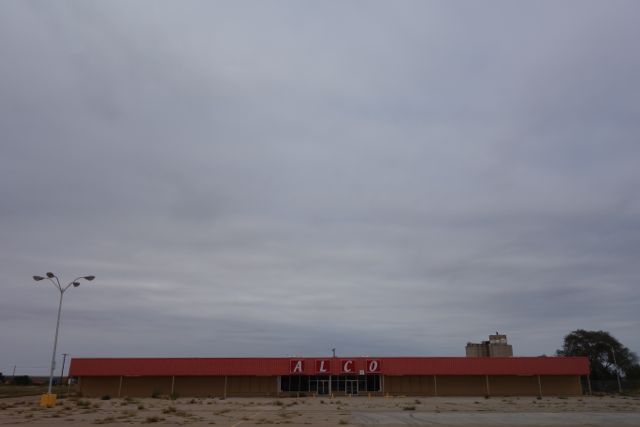
Wide patches of barren land surround most of Tucumcari’s empty buildings, so you can just drive right up to most of them and snap away. Actually, I should qualify that statement, since some of the ones we drove right up to we found not quite empty, glimpsing through open doors and broken windows the telltale random stockpiles of a squat. But we saw neither hide nor hair of the squatters themselves, and so felt like the only humans alive for miles. With Route 66’s glory days sixty years behind it, barely even saw any other moving cars.
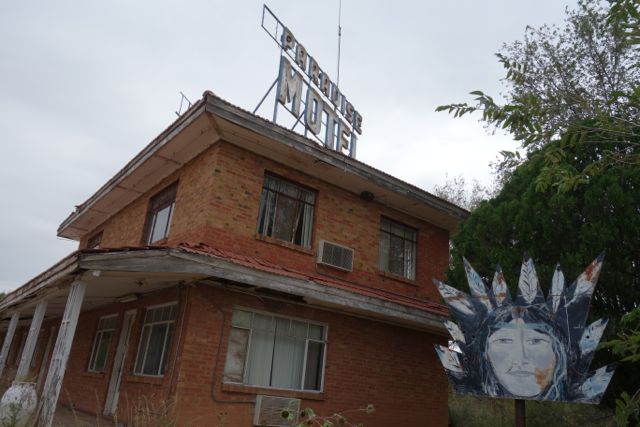
Having geared up in recent years to leave the United States, I’ve more and more frequently explained my departure by comparing aspects of this country (especially its infrastructure) to the third world — unfavorably. The crumbling desolation of Tucumcari might at first seem like yet another glaring signal of the de-developed America in which we find ourselves, but I haven’t even seen anyplace like it in the third world itself. In Latin America or southeast Asia, a town like this would be full of people — poor, for sure, probably even poorer than the people of Tucumcari, but in sufficient numbers and possessed of enough of an improvisational spirit to keep the place looking alive.
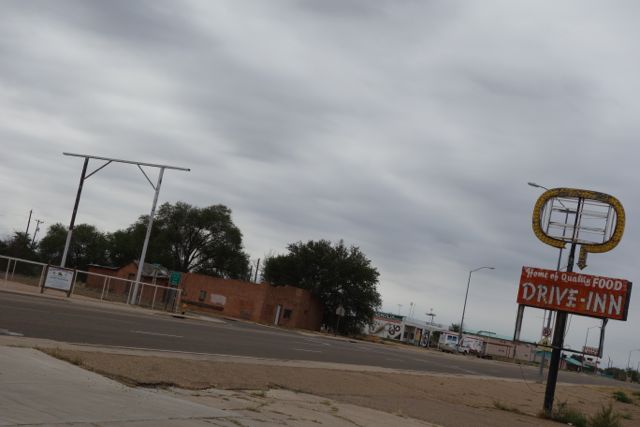
If this trip has taught me anything important about America so far, it’s taught me, viscerally, about the country’s sheer size. A Korean friend of mine perpetually entertains a fantasy about driving through North Dakota — always North Dakota — with nothing on either side of her for miles and miles (or rather, kilometers and kilometers), I would guess for no reason other than that she’d have a hard time doing the same in Korea. Indeed, I’ve found that in America, you might easily spend two or three hours just trying to get through the blank expanse between one hamlet and another. And given how much space lies between them, some of those hamlets just get forgotten.
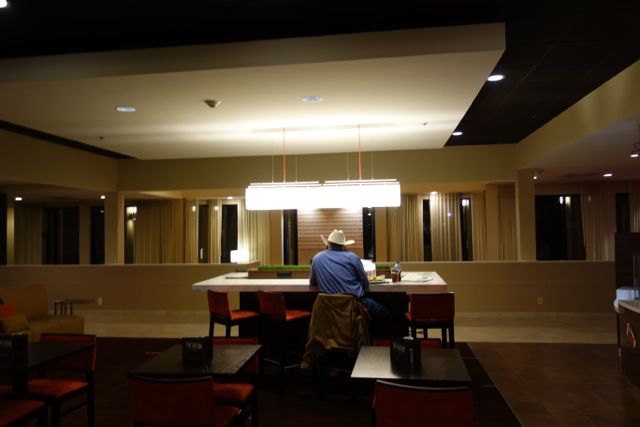
I’d looked forward to our arrival in Oklahoma City, less because I knew anything about it than because it came after an eight-hour, three-state-spanning drive from Albuquerque, through what I mostly remember as a sense-deadeningly repetitive pastoral punctuated by vast fields of windmills. After that, I felt just about ready to settle forever in any place with “City” in its name. But National Geographic Traveler did also name Oklahoma City among the “20 go-now destinations” on its “Best Trips 2015” list, which fueled my suspicions that we’d find something genuinely worthwhile there.
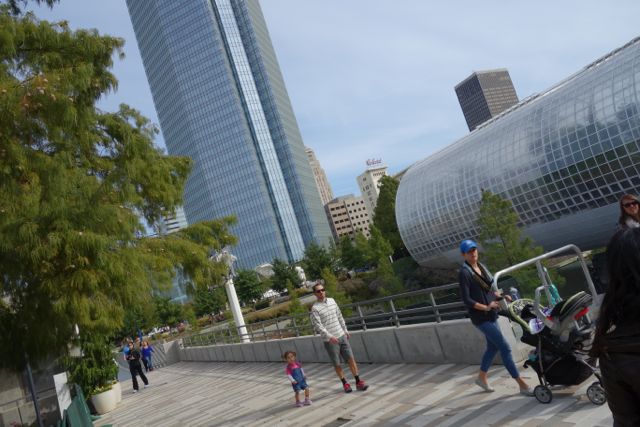
We found, on our first morning, the genuinely worthwhile Myriad Botanical Gardens, an acclaimed (and, coming from California, shockingly bum-free) public space in downtown Oklahoma City just across the street from the Devon Energy Center, the recently built 50-story skyscraper that, so far out of scale with any other nearby structure, pretty much constitutes the skyline by itself. On the opposite side of the gardens, a children’s pumpkin festival had got into full swing, providing perhaps the highest concentration of wholesomeness I’ve ever beheld first-hand. At every intersection, electronic voices offered — and repeated, and repeated — detailed descriptions of which streets we could cross and when. Professional downtown guides zipped by, their canary-yellow uniforms in perfect color coordination with their Segways.

We passed through a few torn-up streets, but they’d been torn up, so the signs informed us, in the name of Project 180, a $176 million pedestrianization scheme, reaching the edge of a neighborhood called MidTown (yes, capitalized T). There we sat down, across the corner from a tempting ramen joint, for a cappuccino, hot chocolate, and “sparkling cold brew” among the bearded baristas, MacBooks Air, and Macklemore haircuts of Elemental Coffee. They’d even put up a stand of tools with which to tune up your bicycle while awaiting your drink (which will sometimes require, as the beards put it, a serious “time investment”). But you won’t have to worry about that if you use Spokies, the city’s bike share system, which has placed one of its stations right in Elemental’s parking lot. Clearly, the center of Oklahoma City, in common with many other greater downtown areas across America (some of which we’ve experienced on this very trip), has a revival going on.
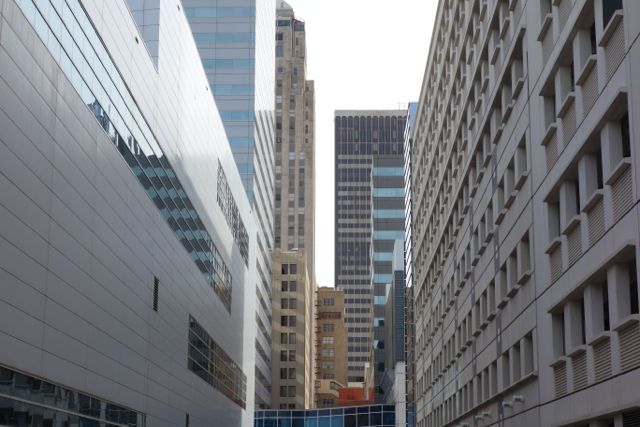
Still, mention the name Oklahoma City to anyone outside it — and surely some inside it — and they think of one thing and one thing only: the 1995 bombing of the Alfred P. Murrah Federal Building. Though only ten years old and in Seattle at the time, I still remember the day it happened, and from then on the disaster, for me as for so many others, stood for the city. I didn’t imagine then that I’d ever have occasion to visit Oklahoma City myself, much less the memorial grounds to be one day built on the Murrah building’s cleared footprint. But there I ultimately went, and there I saw the bronze gates, one representing the minute before the explosion, one representing the minute after. Between them stretches a shallow reflecting pool (dotted, dispiritingly, with pennies), and beside that stand 168 sculptural empty chairs. It ranks high among the massacre sites I’ve seen, lacking either the sinister feeling of Tlatelolco or the whole city of Hiroshima’s faint air of unreality. (The giant weeping Jesus across the street does go a bit far, but a Methodist church built it on their own property.)
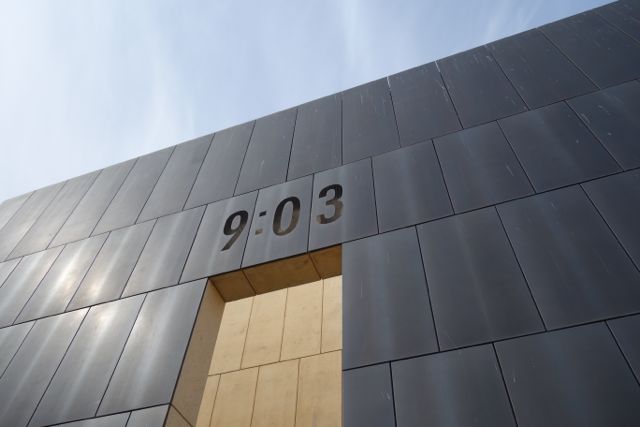
On a length of chain-link fence hang stuffed animals (the building’s day care center having infamously absorbed some of the blast and most of the news coverage) and photos of the victims. One studio portrait stood out for its now strikingly retro hair and lighting, and then for the dates below: 1971-1995, 24 years old, hardly more than a girl but not much younger than the bomber himself. The violence of the event haunts me less than the question of how Timothy McVeigh, clearly an intelligent young man of iron resolve and philosophical consistency, somehow arrived, through a seemingly coherent set of principles, at what he saw as the necessary step of car-bombing a federal building. (Incidentally, he did his planning in Kingman, Arizona, where we happened to stop earlier this trip for lunch at a barbecue place called Redneck’s.)

I don’t want to overstate this point, but I’ve spent a great deal of this time behind the wheel trying to understand something more of America, and from that perspective I see McVeigh as not just a “domestic terrorist,” but a thoroughly American terrorist. Brought up on this country’s mythology, more than a few of us entertain the fantasy that we, too, might one day grow into tyrant-toppling outlaw. Many more of us harbor an inherent distrust and even perpetual suspicion of any visible center of power, especially one as colossal as the federal government of the United States: we think of the state as not Us, but Them. McVeigh certainly regarded it as Them, and as malevolent a Them as They come, insisting on describing his act in Oklahoma City as “morally equivalent” to the recklessness of the U.S. government not just at home (he framed his bombing as “counter-attack” in a war initiated by the United States at Ruby Ridge and Waco) and abroad: “Remember Dresden? How about Hanoi? Tripoli? Baghdad? What about the big ones — Hiroshima and Nagasaki?”

Few Americans, I suspect, feel active guilt about the Dresdens, Hanois, Tripolis, Baghdads, Hiroshimas, and Nagasakis of the world, due to a tribally instinctive categorization of the foreigners there, even noncombatants, as Them rather than Us. (I admit to feeling no guilt myself at Hiroshima, less because I regard wartime Japanese as Them than because I regard the Americans who ordered the bombs dropped as an even more alien Them.) McVeigh abandoned that particular concept of Us and Them (to say nothing of “two wrongs don’t make a right”), and so the death of innocents in one place looked as unjustifiable, and so as justifiable, to him as the death of innocents in another — a sentiment with which all 21st-century American liberals would surely agree. For most of us, the less we think in terms of Us and Them, the more humane individuals we become. Timothy McVeigh, on the other hand, became the deadliest mass-murderer in American history.

Ozark, Arkansas — it sounds like the name of a freeway exit you’d take pains to avoid using, or the name of one of those forbidding small towns in movies where the main character’s car breaks down and Bad Things Happen but you ultimately kind of blame the victim because, come on, Ozark, Arkansas. But we took the Ozark offramp with the greatest deliberateness, aiming for an early dinner at Rivertowne Barbecue, which came recommended to us by a genuine Arkansas native back in Los Angeles. You’ll notice I linked to Rivertowne’s web site, the fact of whose existence alone I found reassuring: it’s okay, they know about the internet, this is modern, literate, non-lawless Ozark of the 21st century.

Still, I had low expectations, less in the Deliverance sense than that I’d envisioned Rivertowne, which first opened in 2000, located in a dreary, auto-oriented strip the likes of which I’ve already seen more than enough of sprouting off and alongside Interstate 40, maybe between a Wal-Mart on one side and a Sam’s Club on the other. But we found it in a traditional, almost classical town square that looked to have hosted an event involving quite a few tents, trucks, and stands just an hour or two before. There, hung in the back of one of the trucks whose owners hadn’t yet finished packing up their wares, I noticed the first Stars and Bars of the trip so far. I wondered how wary I should feel at finally spotting this ultimate signal of Confederate pride, or whether it should pleasantly surprise me that I’d spotted so few so far, or whether any of it meant anything at all.

Mostly I just felt hungry, and ever more grateful for the presence of Rivertowne with each downtown Ozark business, all already closed for the day by late afternoon, we passed along the way. When we sat down to eat, we found that the bustle inside the restaurant balanced out the utter quiescence of the town around it. Artifacts of vintage Arkansas life, including old street signs off the main drag of Commercial Street and a large metal oval mounted above our booth proudly advertising Grapette soda (with “IMITATION GRAPE FLAVOR”) surrounded us, with nary a banner of Dixie to be seen. A framed portrait hanging by the bathroom immortalized Rivertowne’s first paying customer. A high-heeled teenager in bright purple jeans came in with her family, the heavy makeup and first-place sash she wore attesting to a fresh beauty-pageant victory.
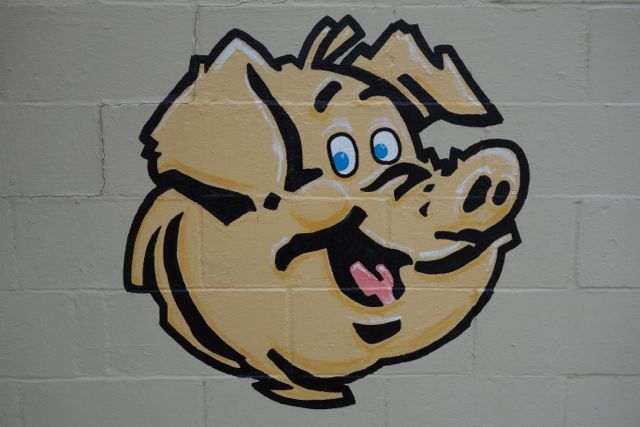
In the unlikely event that I need to come by Ozark again, I’ll make a point of returning to Rivertowne. We speak often — especially often in election season — of the existence of not one but multiple Americas, each of which lives in ignorance and misunderstanding of all the others. I knew this road trip would take us through a host of Americas about which I personally have, to this point, lived in ignorance and misunderstanding, and the likes of Rivertowne, at the hour or indeed in the era when the emptied-out town square retains the form but no longer fulfills the function, provides a visually and sonically (they have accents here!) rich observatory of this particular America in action. And it also offers an equally satisfying plate of brisket, pork, ribs, and “Texas toast” superior, I might add, to the Texas toast I had at our last barbecue stop — in Amarillo, Texas.
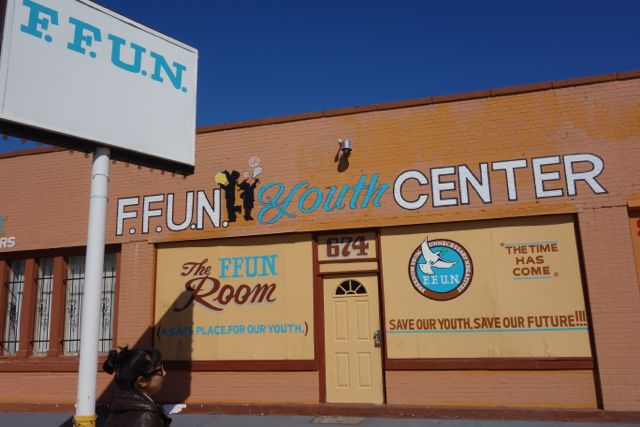
We pulled into Memphis at night and drove to Knoxville the following day, stopping in Nashville somewhere in the middle, then rolled on to North Carolina the morning after that. If you need to see the three biggest cities in Tennessee and have absolutely no more than 36 hours in which to do it, I can tell you how we did it.
We began with a bracing shot of déjà vu, dragging ourselves into the lobby of the Memphis Courtyard by Marriott that looked and felt in all respects identical to the lobby of the Oklahoma City Courtyard by Marriott in which we’d drank away the vibrations of the road the day before. At first I assumed the details would differ. Surely the Memphis instantiation of The Bistro wouldn’t have the same folksy chalkboard with its handwritten imperative to “Try Our Classic Oatmeal.” But it did indeed have the same folksy chalkboard — just propped up on the opposite shelf.
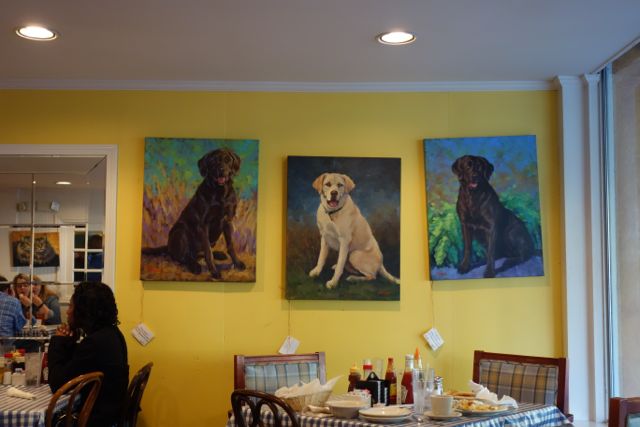
I never tried their Classic Oatmeal. I always get excited about complimentary continental breakfasts at hotels (despite seldom eating anything from them but Raisin Bran), and at this point in life have come to expect them as a standard offering of the traditional hotel industry, perhaps the sole remaining reason not to go with an Airbnb 100 percent of the time (though I’ve noticed many Airbnb hosts raising their breakfast game lately).
Bizarrely, Courtyards by Marriott don’t offer a continental breakfast, an unexpected point of tackiness I pondered while drinking my three-dollar coffee from The Bistro. But the lack of free Raisin Bran meant a chance to eat at a downtown institution instead, and so we ended up Sunday-brunching at the Blue Plate Cafe, where we put away a few omelets under the happily vacant gaze of dozens and dozens of dog portraits, their painter one of Memphis’ very own.

I find few activities as pleasurable as discovering an unknown downtown on foot, and I looked forward to seeing what Memphis’ had to offer with the aid of its historic streetcar lines. Alas, I found whole system shut down for renovation since a fire in 2013, and its rails and stations remain silent today.
So instead of my usual improvised downtown tour, we opted for a tour of the official variety: specifically of Sun Studios, which some might know as the place Elvis got his start, but others, people like me, might know as the place to which Youki Kudoh and Masatoshi Nagase make their pilgrimage in Jim Jarmusch’s Mystery Train. Only one member of our tour group had managed to put together a credible 1950s rocker look for the occasion — pompadour, sideburns, cuffs, Converse — and he, not that surprisingly, turned out to have come all the way from Switzerland. Lucky nobody Japanese had turned up; they’d surely have eaten his subcultural lunch.
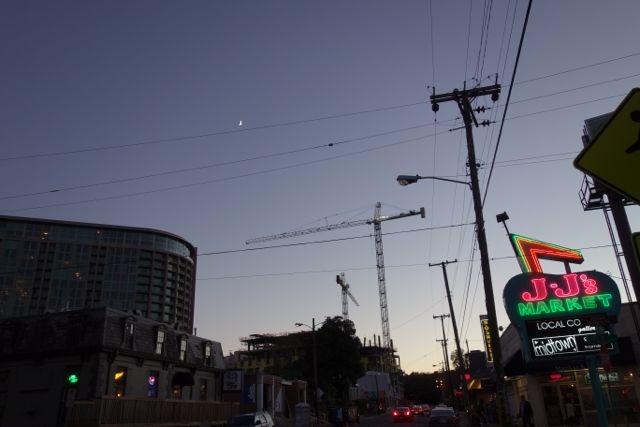
Tennessee ranks as only the 36th largest state in the Union (and actually, it roughly matches the size of South Korea, though Indiana, number 38, gets closer), but it still takes between three and four hours to drive from its first city to its second. The high-rises and elevated freeways of Nashville (not to mention its scores of construction cranes, hard at the apparent work doubling the size of the city) came into view just as the desperation for some urbanity was about to get the better of me.
We’d also felt a desperation for nachos for some miles, and so made for an oasis in Midtown (not to be confused with Oklahoma City‘s MidTown) called, simply, Tavern, whose staff, seeming to sense our weariness, seated us in a corner circular booth of our own, poured us some restorative cider and sangria, and served us a heap of tortilla chips, cheese, guacamole and something called “angry chicken.” On the table stood a variety of hot sauces, three of which came in brown eye-dropper bottles labeled only “X,” “XX,” and “XXX.”
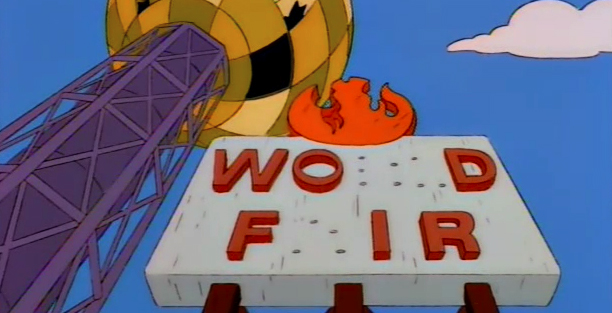
After dinner we took a walk through Music Row (small speakers embedded in whose sidewalk utility boxes pipe out the hits 24/7), ending up at the kind of third-wave coffee shop, built in the comparatively cavernous space of a renovated garage, that makes you wonder not whether you could move to its city, but how soon you should. It helped that, from what I could tell through their illuminated floor-to-ceiling windows, all the nearby condos (whether still under construction or very recently finished) looked comfortable indeed.
Part of me wondered if I’d see anything like it in Knoxville, but a bigger part of me — just like any thirty-year-old American male, and thus exegete of The Simpsons‘ 1990s golden era — wondered what I’d find when I made my own pilgrimage to the Sunsphere, at which Bart, Milhouse, Martin and Nelson once arrived fourteen years too late for the 1982 World’s Fair (and ultimately knocked over).
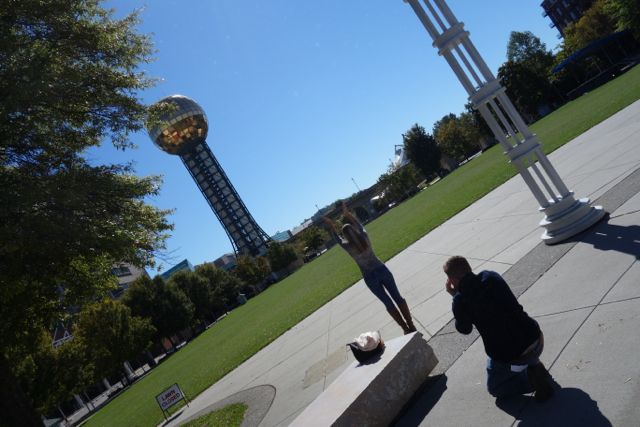
I enjoy old World’s Fair grounds, and the park Osaka maintains at the site of Expo ’70 remains, for me, the old World’s Fair grounds to beat. Knoxville’s modest but pleasant equivalent doesn’t beat it, but there you can visit the Sunsphere’s observation deck and behold all of Knoxville laid before you for free, each vista’s accompanying display informing you of, say, the city’s title of red panda capital of the western hemisphere. (It reminds me of the non-free towers that overlook some Asian cities, especially Busan’s, though the Sunsphere boasts something called the “Icon Ultra Lounge” — currently closed, like Memphis’ trolleys, for renovation.)
If I lived in Knoxville, I’d live in the condo building with the best Sunsphere view, a converted candy factory from the turn of the 20th century with a chocolate shop on the bottom floor. As I stocked up on Sunsphere bars there, the owner excitedly told us about the coming developments in Knoxville’s own downtown revitalization, working in a sentiment I’ve heard in almost every city on this trip, and indeed almost every city in America from Los Angeles on down: “If you’d told me this place was going to come back to life ten, fifteen years ago, I’d never have believed you.”
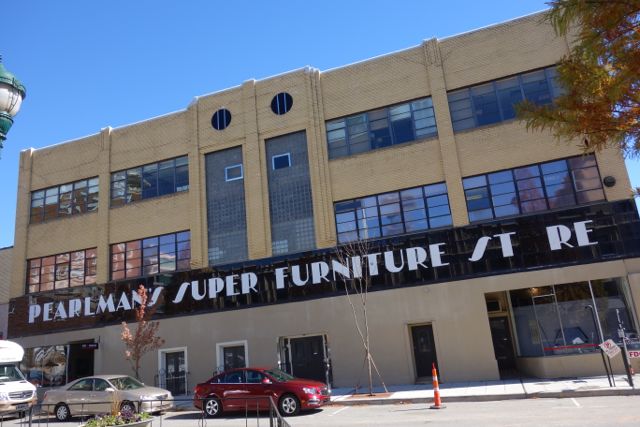
Before arriving in Raleigh, the final destination of this cross-country road trip, we stopped in Asheville, one of those places often found alongside the likes of Athens, Georgia and Marfa, Texas in clickbait slideshows about America’s Coolest Cities of Under 100,000 People. It didn’t answer my long-standing question about who’s doing the clicking and why (coolness or low population; you kind of have to choose one), but I could see why it impresses visitors: it has well-regarded bookstores; it has an architecturally sound and human-scaled downtown (still an astonishing novelty to so many Americans); it has a pinball museum (closed, alas, when we passed by); it has a confectioner who makes shoes out of chocolate.
I didn’t leave with a chocolate shoe, but I did leave with a copy of Lawrence Osborne’s Paris Dreambook purchased, after flipping through it over a generous cheese plate, from the well-curated and highly explorable Battery Park Book Exchange and Champagne Bar (the name alone…), located in a restored shopping arcade somewhat reminiscent of the Bradbury Building back in Los Angeles. Despite having sworn off purchasing books in the months before my move to Korea, I do make exceptions for volumes on cities (professional interest, surely you understand), especially when I personally like the writer (and my interview with Osborne about his Bangkok book remains one of my very favorites from the Marketplace of Ideas days).

Apart from Quail Ridge Books, an event-intensive strip-mall bookstore beloved of no less a locally raised man of letters than David Sedaris (whose signed portrait, hung in the bathroom, reads “I was a monster in 2009”), Raleigh, or at least my experience of Raleigh, seemed to me less about books than about food. Calvin Trillin wrote at length about the struggle for the soul of North Carolinian barbecue in the New Yorker just the other day, naming Raleigh as “the line of demarcation that separates the two principal schools” of that culinary art form.
But ironically, North Carolina counts as the sole barbecue-oriented state we passed through on our road trip in which we ate no barbecue at all: we had it in Texas, we had it in Arkansas, and we had it in Tennessee, but we wholly missed out on both eastern North Carolina’s version, “where barbecue means the whole hog, chopped, with a vinegar-based sauce that is flavored with pepper,” and western North Carolina’s version, which “uses only pork shoulders, chopped (or, sometimes, sliced), with a sauce that is also vinegar-based but has been turned pinkish by the addition of ketchup or tomato sauce.”
We did, however, eat Korean food, or in any case an intriguing local version of Korean food. After ten days on the road, I’d worked up a mighty craving for even a simple kimchi jjigae (or especially a simple kimchi jjigae), and so we stopped in for lunch at Kimbap, a “Korean-inspired” cafe in what I understand to be the Raleigh’s most interesting current food neighborhood outside downtown. If the menu offered kimbap I didn’t see it, but the dishes we did find provided a tasty experience at the intersection of traditional Korean food and hardcore North Carolina locavorism. (Its kimchi had a refreshingly vinegary taste — a distant echo, perhaps, of the eastern North Caroninian love of the stuff in their barbecue?)

We had a chat with the chef, a Korean-born, Michigan-raised adoptee who surprised us with the revelation that she’d never once set foot in the land of her ancestors (not to mention the land of our next residence) after her adoption. I insisted that she visit, if only because she seemed like the ideal person to enjoy a food tour there, but Kimbap has cleared the bar of two and a half years in business, keeping her busier and thus less able to travel than ever with its ongoing demonstration of the apparent viability of selling Korean cuisine to Raleighites.
But the market hasn’t yet reached a saturation point, as indicated by the restaurant’s chopsticks, which come in sleeves printed with directions for how to use chopsticks. If I’d seen that in California, I’d have taken it as an attempt at irony, but North Carolina didn’t strike me as a particularly ironic place. Even there, though, I wonder how long we’ll see this sort of thing. I can’t think of a single American friend of my generation unable to eat with chopsticks, but I get the sense that Asia itself hasn’t yet got word about how thoroughly their stateside usage has spread.
My own unhesitant (if not unusually skillful) chopsticking has drawn expressions of astonishment from certain Koreans in both their homeland and mine, a reaction often revealing more surprise than the one I get when I actually speak Korean — though I did score a twofer once when, at a Koreatown Korean Chinese restaurant (a distinct variant of Chinese cuisine, with dishes as signature as though much more defined than American Chinese food’s orange chicken and chop suey), I explained in that language to the middle-aged lady who suddenly appeared at my side two-handedly proffering a fork that, thank you, but I didn’t need one.
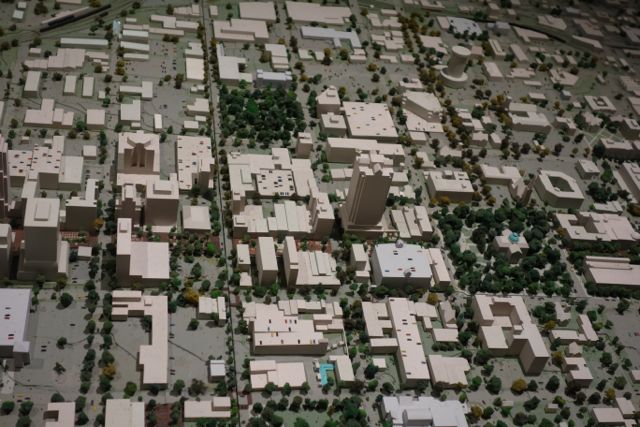
We ate more often downtown, and you can’t talk about downtown Raleigh food, so I gather, without taking about Ashley Christensen, the well-known chef who runs seven popular bars and restaurants in the city. We got to four of them in the span of two days without really trying: Beasley’s Chicken + Honey, a sort of North Carolinian Roscoe’s Chicken and Waffles; Chuck’s right next door, a specialty hamburger joint boasting myriad French-fry dipping sauces; Fox Liquor Bar, a brick-walls-and-bare-bulbs sort of place underneath Beasley’s and Chuck’s; and Poole’s, a new-wave diner open late enough for us to hit up after an event (although “late” in this case means midnight, a sign that downtown Raleigh has a little way to go yet, though huge swaths of Los Angeles suffer exactly the same problem).
Of course, I imagine that some hardcore Raleigh eaters and drinkers disdain Christensen’s restaurants in the same way that some hardcore Portland eaters and drinkers disdain the McMenamin’s establishments. But you know what? I’ve drawn great pleasure indeed from every McMenamin’s place I’ve visited, and at this point a visit to Portland wouldn’t feel complete without at least one. (It does boggle my mind, though, that with the Anderson School they’ve expanded into Bothell, Washington, the crappy suburb next to the crappy suburb where I went to high school.) Maybe, a few Raleigh trips from now, I’ll come to feel the same way about the Christensen empire.

Raleigh’s other urban amenities I find it a bit harder to judge. Like many midsize American cities, it lacks even the most basic rapid transit system, though discussions have begun; in the doorway of a gift shop I found brochures detailing the pros and cons of rail versus bus rapid transit, though nothing will actually happen until 2026 at the earliest. I didn’t get the chance to ride the R-LINE, a nifty-looking free downtown circulator bus (albeit one that only goes in one direction and only comes every fifteen minutes). But we did stop by the also-free City of Raleigh Museum, whose maps and models on display give a sense of the city’s layout and how it developed. (I wish every city had one of those; I’d make them the first stop as a rule.)
As always, on American road trips or any other form of travel, the most memorable things come unexpectedly. I put the call out on Twitter for recommendations from Raleigh urbanists, and someone replied to suggest the Contemporary Art Museum Raleigh’s kissa, held weekly on the building’s bottom floor and modeled after the 1950s Japanese kissaten, “bars and cafes where music lovers could share their record collections with devoted and curious listeners.”
On the week we happened to attend, we drank wine while listening to selections from the formidable collection of Marshall Wyatt, proprietor of vintage-Americana label Old Hat Records, concluding our journey through America’s present with a plunge into America’s past. Toward the end of the evening, Wyatt pulled out a piece of vinyl to which he said he wanted to give a special introduction, one that would let him “say the three words every collector longs to say: only. Known. Copy.” Misuse of the word “unique,” a habit common to American speech, has started to grate on me after thirty years here (maybe that along has driven me to Korea), but here we had a genuine opportunity to use the word: a unique recording in a unique country.